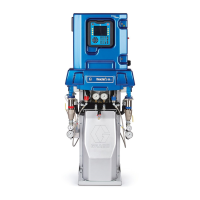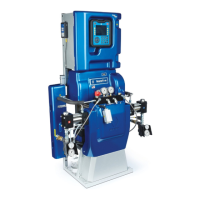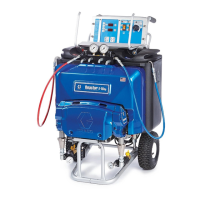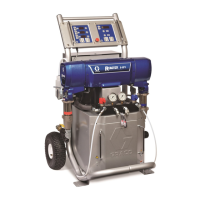Troubleshootin
g
Problem
Cause Solution
FTS failed. Check FTS, see
Repair Fluid
Temperature S
ensor (FTS), page
74.
FTS not installed correctly. FTS should be installed close to
end of hose in same environment
as gun. Verify FTS installation,
see Repair Fluid Temperature
Sensor (FTS), page 74.
Loose hose e
lectrical connections.
Check connections. Repair as
necessary.
Circuit b
reakers tripped.
Reset bre
akers (CB01 ), see
Repair Ci
rcuit Breaker Module,
page 63.
Hose zone not turned on. Turn on hose heat zone.
Hose does not heat.
A and B temperature setpoints too
low.
Check. I
ncrease if necessary.
Hoses ne
ar Reactor are warm, but
hoses d
ownstream are cold.
Shorted connection or failed hose
heating element.
With power off, check the hose
resistance with and without the
whip hose attached. With the
whip hose attached, the reading
should be less than 3 ohm. With-
out the whip hose attached, the
reading should be OL (open loop).
See Check Hose Heat Power
Connectors, page 71.
A and B temperature setpoints too
low.
Increase A and B setpoints. Hose
designed to maintain temperature,
not increase temperature.
Hose
temperature setpoint too
low.
Check. Increase if necessary to
maintain heat.
Flow too high. Use smaller mix chamber.
Decrease pressure.
Low current; FTS not installed. Install FTS, see operation manual.
Hose heat zone not turned on long
enough to reach setpoint.
Allow hose to heat up, or preheat
fluid.
L
oose hose electrical connections.
Check connections. Repair as
necessary.
Ambient temperature is to low Relocate hoses to a warmer area
or increase A and B setpoints.
Low hose heat.
If Hose Resistance Mode is
enabled, the calibration factor may
be inaccurate.
Re-calibrate the hose. Follow the
Calibration Procedure, page 75.
46 333024N

